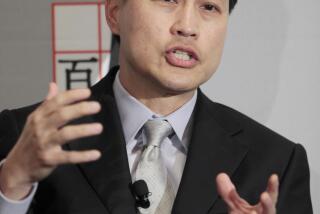Bank Lends a Hand With Foreign Finance
Want proof that bankers want very much to lend money to small business these days--indeed, that they actually create new ways to do it?
Listen to the story of Bill Angus, senior vice president and chief financial officer of Cymer Inc., a San Diego supplier of excimer laser illumination sources used in the manufacture of semiconductors.
Cymer went public in September 1996, raising $32 million in an initial offering and $84 million in a secondary offering the following December.
Before it had access to the public markets, however, Cymer needed to raise working capital for a subsidiary, and Angus faced two problems: The subsidiary was a Japanese company, and it sold to Japanese customers, among them Nikon and Canon.
Angus would have had no trouble borrowing against the receivables of a U.S. operation with stateside customers comparable in stature to Nikon and Canon. But he needed working capital for a foreign company with foreign receivables--a tall order.
That’s because it’s hard to “perfect” a lien against receivables in Japan and it’s even harder for a U.S. creditor to collect in the event of default.
What to do? With the help of the U.S. Export-Import Bank and Silicon Valley Bank, an aggressive lender that specializes in high-tech companies, Angus found a new way to isolate the risk inherent in lending against foreign receivables. In the process, he blazed a trail in financing foreign trade.
*
His success is good news for business owners because it shows how banks invent new ways to lend money in a growing economy. Indeed, banks are flush with cash these days, and they compete hard to put that cash to work, even lending to fledgling businesses before they turn a profit and sometimes before they generate revenue at all.
In Angus’ case, Silicon Valley Bank came up with a simple solution to the obstacles to lending on foreign receivables. It contracted with a Japanese bank to collect and remit the receivables to Cymer through Silicon Valley Bank.
The arrangement did not give Silicon Valley Bank a guaranteed means of collecting in the event of default, as would a lien. But it worked because:
* Silicon Valley Bank saw the value of receivables from companies like Nikon and Canon, just as any bank sees value in the receivables of any U.S. borrower.
* Silicon Valley Bank knew the Japanese bank would remit the funds with which Cymer could service the loan.
“It is exceedingly cumbersome to perfect a security interest under Japanese law,” said John Otterson, a Silicon Valley Bank senior vice president in San Diego.
“Doing so requires that you time-stamp every invoice as it goes out, and even if you follow all the procedures, the perfection is still subject to review by the Japanese Ministry of Finance.”
But Otterson understood that, to a bank, perfecting a lien is a means to an end--namely, collecting on a loan--but not the only one. He could not secure his risk with a legal interest in Cymer Japan’s receivables, so he did the next best thing. He partnered with a Japanese bank to make sure that, as the receivables turned into cash, the cash ended up in Cymer’s account.
*
Otterson also persuaded the U.S. Export-Import Bank to underwrite the arrangement. Ex-Im guarantees loans made by U.S. banks against the foreign receivables of U.S. companies. This time it underwrote the foreign receivables of a foreign subsidiary of a U.S. company--a first for Ex-Im.
“John Otterson had some good arguments to present to Ex-Im,” Cymer’s Angus said. “If the government wants U.S. companies to be competitive in Japan, and if it wants the Japanese to import U.S. goods, why not help companies do business there?
“Why force U.S. companies to find a Japanese middleman? Why not help U.S. companies to set up Japanese subsidiaries and do business there just like anybody else does?”
The arrangement gave Cymer access to capital to expand its Japanese operations, just like it might expand its U.S. operations by financing domestic receivables, Angus said. The difference, of course, was that the receivables being financed were overseas assets.
*
Angus faced another problem earlier this year and called on Otterson again to help him solve it.
Using the capital raised in its public offerings, Cymer had paid down its debt and lent $10 million in working capital to its Japanese subsidiary on its own hook. But in going public, Cymer also had become subject to federal laws requiring that it “mark to market” the value of that $10-million loan--and as the yen dropped against the dollar, so did the value of this loan as an asset.
Partnering with the same Japanese bank that had collected Cymer Japan’s receivables, Otterson arranged a loan in yen, equivalent to about $8 million, to Cymer Japan, at interest pegged to the Tokyo interbank rate.
The new arrangement erased the loan from Cymer’s balance sheet, even as it allowed the company to further its aims in Japan despite the Asian financial crisis, according to Angus. The loan also shifted the risk of any further drop in the value of the yen to Silicon Valley Bank, which hedged the risk by buying futures contracts against the currency.
The key to this deal, and to the earlier loan against receivables, Angus added, was that in Silicon Valley Bank, the company found a lender sophisticated in the borrowing needs of a specific industry--an important asset in a complex economy, and, happily, not at all unusual these days.
*
How to get financing will be a topic of The Times’ Small Business Strategies Conference Oct. 17-18 at the Los Angeles Convention Center. Columnist Juan Hovey will be featured. He can be reached at (805) 492-7909 or via e-mail at jhovey@gte.net.
More to Read
Inside the business of entertainment
The Wide Shot brings you news, analysis and insights on everything from streaming wars to production — and what it all means for the future.
You may occasionally receive promotional content from the Los Angeles Times.








